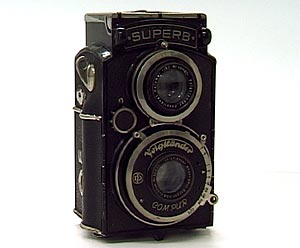


At any rate, Superb is a unique, original camera. When classifying this camera, it goes into the category of 6 x 6cm format TLR camera using 120 roll film with no doubt. But still, this is somehow different from other, so to speak, normal TLR cameras. On the occasion of entrance into the TLR camera market that had been cultivated in 1929 by Franke & Heidecke KG., Voigtlander launched Superb that was designed, throughout every details, in anti-Rollei position. This was because Voigtlander, not just imitating Rollei TLR camera, intended to mark its personality and identity on its products.The first thing to mention is its film transportation mechanism. While on Rollei-type TLR cameras, the film is transported vertically from bottom to top, on Superb, the film is transported horizontally from right to left, and for that reason, its rear cover open horizontally. And film winding is done by ratcheted lever settled horizontally on the camera.
In addition, the film is not transported automatically to the next exposure on this camera.One other unique feature is that the shutter speed numbers on its dial are engraved in reverse side and the correct figures can be seen from the camera top through a little prism attached to the camera front. And also, aperture dial is settled not on the lens but on the camera body. All these make it possible to see all the informations - an image on the focusing screen, the aperture value and the shutter speed - from the camera top when taking pictures.
And most noteworthy feature of this camera is its prominent focusing mechanism. On this camera, focusing is done by the straight helicoid, and the helicoid rotation of the taking lens couples with the view lens by the medium of the gear settled between them.
One of the problem on TLR camera is parallax caused from the difference of the position of the taking lens and the view lens, and it becomes worse as the camera is set closer to the subject. On Superb, Voigtlander resolved this problem in an original way. The view lens is put in double lens housings and is designed that it gets tilting downward as it is extended by helicoid. And the mirror and the focusing screen, that were put together in one box, is always matches with the view lens movements to remain the optical axis of the view lens parallel with them. In other words, all these three correct parallax by tilting downward as the view lens extended out.Well then, let's take a look at it.
- First introduced in 1935 by Voigtlander.
- Camera type : 6 x 6cm format TLR camera
- Camera body : aluminum-alloyed diecast
- Film : 120 roll film
- Taking lens : Voigtlander Anastigmat Skopar f3.5/75mm (or Heliar f3.5/75mm)
- View lens : Voigtlander Anastigmat Helomar f3.5/75mm
- Shutter : S-Compur #0
- Shutter speeds : T, B, 1, 1/2, 1/5, 1/10, 1/25, 1/50, 1/100, 1/250 sec., Self-timer built in
- Aperture : f3.5, 4, 5.6, 8, 11, 16, 22, iris diaphragm
- Focusing : straight helicoid, automatic parallax correction
- Film winding : manually by the film wind lever
- Body dimensions : 90 x 138 x 92mm
- Body weight : 890 g.
|
| Back to Camera Shopper | Back to Index Page |